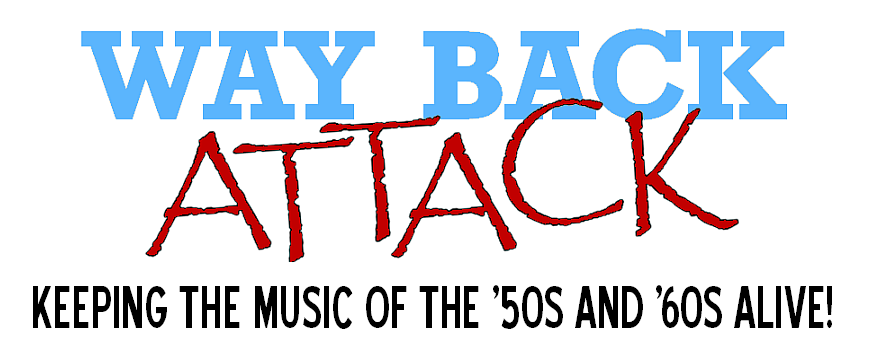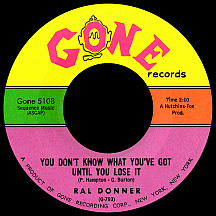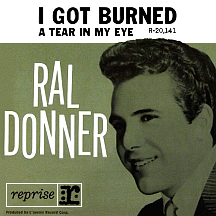RAL DONNER
You Don't Know What You've Got
Until You Lose It
The greatest of all Elvis Presley imitators! Not really a distinction to shoot for, but it was a cross someone would ultimately have to bear. Ralph Stuart Emanuel Donner cast a convincing trick on the ears, fooling people into thinking some of his records were by "The King" himself; even his speaking voice was remarkably similar to the Mississippi-born son of Vernon and Gladys. It was a distinction he embraced over time, at one point taking on a project that required him to further perfect his Presley impression. A northern boy from Chicago's Norwood Park neighborhood, Donner was a fan of Frank Sinatra in his youth; a frequent soloist in church choir, he'd learned to play piano, guitar and accordion by the time he turned 13 in February 1956, just as America was on the cusp of its obsession with Elvis.
He began showing off his vocal chops at Taft High dances and assemblies. Elvis performed in concert at the International Amphitheater in March '57 and Ralph was there; he put a band together called The Rockin' Five (six members including himself) that included two of his best friends, guitarist Alan Sears and bassist Jack Burke. Nightclub gigs were offered and they performed several Presley tunes; Donner even imitated his newfound idol's dance moves from the big prison production number in the movie Jailhouse Rock. In January 1958, the band made an acetate recording of Little Richard's "Miss Ann," then a big break came when they were hired by Chez Paree, a top Windy City supper club, to play Sunday matinees for the younger crowd. Soon he was appearing on a new local TV show, Time For Teens, broadcast from the Chez and hosted by Stan Howard (who called himself "America's Oldest Teenager").
Being welcomed into the Chez Paree was no mean feat for the teenage high school band. The biggest showbiz celebrities performed at (and were patrons of) the posh nightspot; Sammy Davis Jr. was so impressed by Ral (he had shortened his name by that time) that in April the group was tapped to open for Sammy at Harlem's Apollo Theater, where a white 15-year-old singer was a rarity. But Sammy knew what he was doing and Ral's Rockin' Five made the grade. Later the same month, they were hired as one of the local acts on Alan Freed's star-packed "Big Beat" show at the Chicago Opera House.
The Rockin' Five broke up that summer; in February of '59 Ral went to Memphis to do some recording at Pepper Studios (of course he would have preferred Presley's former Sun Records hangout). "That's All Right With Me" and "Tell Me Why," both penned by Gerald Nelson and Fred Burch (who'd supplied some "Tragedy" for Thomas Wayne), were uptempo tracks featuring female backing singers and Elvis's main bassist Bill Black. The single was released that fall on Scottie, a small southern label, resulting in a promotional tour of the deep south with Ral's new group The Gents (Jack Burke was back on board) and an appearance in Chicago on Jim Lounsbury's Record Hop, a popular teen dance show. Though the record failed to sell, Ray Smith slipped his arguably superior version of Ral's A side (as "That's All Right") onto the B side of his early 1960 hit "Rockin' Little Angel."
While visiting family in Orlando, Florida in 1960, Ral laid down a few tracks at the Fox Talent Studio in Azalea Park including "Girl of My Best Friend," a song by Beverly Ross and Sam Bobrick from the album Elvis is Back! Ral had sung plenty of Presley songs (in this case he had help from a local group, The Starfires), but the idea of actually committing one to vinyl made him nervous; would people think he was nothing more than a budget-label copycat? George Goldner of Gone Records in N.Y. didn't think so when he picked up the track for release, treating it like the Elvis hit that "could have been." Chicago led the way as it soared to number two on the WLS survey in April, then the rest of the U.S. followed suit and it reached Billboard's top 20 in June '61 (several artists followed Ral's example; later that summer, Hoosier Joe Dowell's non-soundalike take on E.P.'s G.I. Blues tune "Wooden Heart" made it to number one).

Goldner's strategy was to stay away from a Presley-style sequel....if such a thing was even possible. He pressed up copies of "To Love," set to the hundred-year-old melody "La Paloma," but changed his mind (a few months later the tune appeared as "No More" on Elvis's Blue Hawaii soundtrack). The same label number was used for "You Don't Know What You've Got Until You Lose It," a Paul ("Sea of Heartbreak") Hampton-George Burton song with an arrangement similar to Donner fave Jerry Butler's smash "He Will Break Your Heart." It had a nice Elvisesque 'Uh-huh-huh...' and turned out to be the right choice, a top five hit in September and Ral's biggest ever. As a bonus, he got to meet his hip-shakin', lip-quiverin' idol that same month during a tour stop in Los Angeles.
A young songwriter named Douglas Lapham began making contributions to Ral's repertoire. "Please Don't Go" landed him back in the top 40 in November while he wooed current hitmaker Linda Scott on tightly-chaperoned dates that seemed mostly for show. A Doc Pomus-Mort Shuman song, "School of Heartbreakers," laid an unexpected egg, so another Lapham song was slated for radio. "She's Everything (I Wanted You to Be)" was the most uptempo and least Elvisy of Donner's hit singles and marked his return to the top 20 in February '62. A spoken passage on the low-charting "(What a Sad Way) To Love Someone" is eerie in its resemblance to Elvis; was it one too many?
The owners of Roulette Records (Gone's parent company), shady dealings their byword, forced Donner's hand; he filed a lawsuit claiming he hadn't been paid for more than two million records sold, but nothing much came of it. Breaking completely with End, he found backers for his own production company, L'avenir, and signed with Reprise Records in late 1962. "I Got Burned," a strong Presleyish rocker Ral wrote himself, was the highlight of several singles he made for Sinatra's recording enterprise, yet it barely registered on the charts. Later efforts appeared on Fontana, Red Bird (where he briefly reunited with Goldner), Mid-Eagle and Rising Sons, followed by smaller labels throughout the '70s. After a single and separate album project commemorating the 1977 death of rock's greatest star, he proudly narrated the 1981 documentary This is Elvis.
Ral Donner passed away in 1984, a victim of lung cancer at just 41 years of age. He still has a large fan base, many of them collectors in America and Europe who discovered the singer years after his heyday and grew to appreciate his unique place in rock and roll history. From the perspective of these loyal followers, "You Don't Know What You've Got Until You Lose It" can be considered an appropriate signature song.



